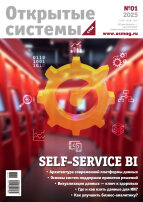.jpg) COVER FEATURES
COVER FEATURES
INTEGRATION
Scaling the Heights of Integration
The majority of companies are just at a "mountain base" in their integration efforts, and with the clouds up there make heads turning, the only way to ascend higher is through services integration. However, the latter is not possible without learning first how to integrate applications and data.
Marina Anshina (Anshina@mail.ru), chair, Standards Committee, Russian Union of CIO
Hybrid Integration
The current state of IT landscape can be described as a hybrid one: business processes are supported by a conglomerate of local, mobile and cloud applications, which should be taken into account when integrating them. The key capabilities of solutions supporting this kind of integration are managing interoperability and metadata lifecycle in real time, which empowers IT managers to take multiple integration products and build a managed integration platform out of them that would be flexible and allow quick modification.
Natalya Dubova (osmag@osp.ru), Associate Editor-in-Chief, Special Features, Open Systems.DBMS
Service-Oriented Architecture and Legacy Systems
Enterprise systems are quickly evolving from monolithic silos to distributed applications with service-oriented flexible usage schemes. To keep up, IT organizations must adapt their legacy systems to meet changing business challenges almost in real time, with no second chances. Service-oriented architectures have evolved to flexibly operate and federate business processes and underlying systems. The Authors provide an overview of current SOA technologies and how to evolve in legacy environments.
Nicola Serrano (nserrano@tecnun.es), professor of computer science and software engineering, School of Engineering, University of Navarra; Josune Hernantes (jhernantes@tecnun.es), professor of computer science and software engineering, School of Engineering, University of Navarra; Gorka Gallardo (ggalardo@tecnun.es), professor of information systems, School of Engineering, University of Navarra
PLATFORMS
Keeping a Supercomputer Operational
A modern supercomputer is a sophisticated multicomponent system every element of which can fail at any time. A high performance computing system, accordingly, requires means of real-time monitoring to assure robust and efficient operation of the components, as well as tools for automatic responding to unexpected events.
Sergey Sobolev (sergeys@parallel.ru), senior fellow, Research Computer Center, Moscow State University
Fabric Computing: The Platform for Clouds
Existing technologies that are used to support cloud services perform the task quite well, yet they were built for the Internet, while fabric computing technologies were specifically created for the cloud.
Leonid Chernyak (osmag@osp.ru), freelance writer, Moscow
IT MANAGEMENT
Putting ITSM under the Microscope
Service management approach could be used both in the realm of IT and outside, including in business management. To assess the value of and demand for the service approach in Russian Federation, the research titled
"IT Service Management in Russia 2013" was undertaken.
Tatiana Orlova (tatiana_orlova@yahoo.com), board member, itSMF Russia, Moscow
SECURITY
The Untapped Potential of Trusted Execution Environments on Mobile Devices
Hardware-based trusted execution environments have been available in mobile devices for more than a decade, but their use has been limited. The On-board Credential system safely opens up TEEs to application developers so that they can implement and deploy mobile services with hardware-assisted security.
Jan-Erik Ekberg (jan-erik.ekberg@trustonic.com), director of Advanced Development,Trustonic; Kari Kostiainen (kari.kostiainen@inf.ethz.ch), postdoctoral researcher, ETH Zurich’s System Security Group; N. Asokan (asokan@acm.org), a computer science and engineering professor, Aalto University
DLP Solutions Turn into Incident Investigation Tools
The use of Big Data technologies is growing wider. In particular, they are being integrated into data loss prevention solutions creating an opportunity to analyze all corporate data flows. The advent of this functionality means that DLP systems transform into incident investigation tools.
Valeriy Korzhov (oskar@osp.ru), freelance writer, Moscow
SOFTWARE ENGINEERING
First, Do No Harm
Let's face it: not all software developers are superstar programmers. This means that when we maintain existing code, we must be very careful to avoid breaking or degrading the system we work on. Why? Because a failure of a running system can affect operations, people, profits, property, and sometimes even lives. Here are the rules.
Diomidis Spinellis (dds@aueb.gr), professor, Athens University of Economics and Business
Performance Testing of Web Applications
Functional and simple load testing have become insufficient for assessing modern Web sites as those methods fail to assure real life performance of web applications. Today, more sophisticated testing solutions are required.
Sergey Leonov(sergei@softlogica.net), staff worker, SoftLogica, Novosibirsk
APPLICATIONS
Lightweight Analytics
Analytics systems are evolving mainly in the direction of processing more data faster, while multidimensional analysis of data stays out of the development mainstream: there are currently no easy or accessible solutions. There is, however, a clear need for such tools in small and medium sized businesses.
Konstantin Seleznyov (skostik@relex.ru), leading software engineer, RELEX Group, Voronezh
EXTREME TECHNOLOGY
Supercomputer out of the Cloud
For some HPC applications, substituting purpose-built machines with a collection of universal cloud modules is impossible. However, there are applications, such as distributed processing of large data amount, that justify the use of cloud computing.
Leonid Chernyak (osmag@osp.ru), freelance writer, Moscow
OS ACADEMY. Workshop
Secure Computation in the Cloud
High-performance computing has become a crucial part of workflow at many organizations, yet most of them cannot afford themselves a supercomputer. An alternative is to rent computer time in the cloud, which however raises concerns related to data privacy. The problem of securing the data is solved through cryptography.
Kirill Bogachev (bogachev@mech.math.msu.su), docent; Evgeniy Popelenskiy (popelensky@gmail.com), graduate student; Andrey Volkov (avolk07@mail.ru), graduate student; department of computational mathematics, MSU Faculty of Mechanics and Mathematics
OS ACADEMY. Library
Applications for virtual reality
The July issue of Computer Magazine (IEEE Computer Society, Vol. 47, No. 7, 2014) covers the topic of new virtual reality applications.
Sergey D. Kuznetsov (kuzloc@ispras.ru), Professor, Moscow State University
